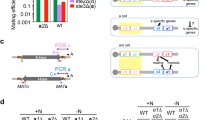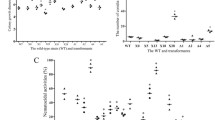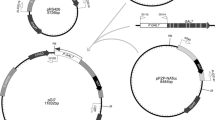Abstract
InNeurospora crassa, mating and heterokaryon formation between opposite mating-types is controlled by a single locus with two alternate forms termedmt A andmt a. Previously, an open reading frame (mt A-1) that confers mating identity and heterokaryon incompatibility was characterized in the 5.3 kbmt A idiomorph. In this study, we describe the structural and transcriptional characterization of two additional genes in themt A idiomorph,mt A-2 andmt A-3. The 373 amino acidmt A-2 ORF has 23% identity to theSMR1 ORF ofPodospora anserina. DNA sequence analysis of a mutation affecting ascospore formation revealed that themt A-2 ORF is truncated to 129 amino acids. The 324 amino acidmt A-3 ORF has an HMG domain and shows 22% amino acid identity toSMR2 ofP. anserina. Transcripts frommt A-2 andmt A-3 are constitutively expressed during both vegetative and sexual reproduction. The presence of upstream ORFs in themt A-2 andmt A-3 transcripts suggests the possibility of post-transcriptional regulation of the expressionmt A-2 andmt A-3 polypeptides.
Similar content being viewed by others
References
Altschul SF, Gish W, Miller W, Myers EW, Lipman DJ (1990) Basic logical alignment search tool. J Mol Biol 215:403–410
Arnaise S, Zickler D, Glass NL (1993) Heterologous expression of mating-type genes in filamentous fungi. Proc Natl Acad Sci USA 90:6616–6620
Bruchez JJP, Eberle J, Russo VEA (1993) Regulatory sequences in the transcription ofNeurospora crassa genes:CAAT box, TATA box, introns, poly(A) tail formation sequences. Fungal Genetics Newsletter 40:89–96
Cambareri EB, Jensen BC, Schabtach E, Selker EU (1989) Repeat-induced G-C to A-T mutations inNeurospora. Science 244:1571–1575
Chang S, Staben C (1994) Directed replacement ofmt a-1 effects a mating-type switch inNeurospora crassa. Genetics 138:75–81
Davis RH, De Serres FJ (1970) Genetic and microbial research techniques forNeurospora crassa. Methods Enzymol 17:79–143
Debuchy R, Coppin E (1992) The mating types ofPodospora anserina: Functional analysis and sequence of the fertilization domains. Mol Gen Genet 233:113–121
Debuchy R, Arnaise S, Lecellier G (1993) Themat-allele ofPodospora anserina contains three regulatory genes required for the development of fertilized female organs. Mol Gen Genet 241:667–673
Devereux JP, Haeberli P, Smithies O (1984) A comprehensive set of sequence analysis programs for the VAX. Nucleic Acids Res 12:387–395
Edelman S, Staben C (1994) A statistical analysis of sequence features within genes fromNeurospora crassa. Exp Mycol 18:70–81
Fourney RM, Miyakoshi J, Day RS, Paterson MC (1988) Northern blotting: efficient RNA staining and transfer. Focus 10:5–7
Frohman MA, Dush MK, Martin GR (1988) Rapid production of full-length cDNAs from rare transcripts: amplification using a single gene-specific oligonucleotide primer. Proc Natl Acad Sci USA 85:8998–9002
Giniger E, Ptashne M (1987) Transcription in yeast activated by a putative α-helix linked to a DNA binding unit. Nature 330:67–672
Glass NL, Lee L (1992) Isolation ofNeurospora crassa A mating-type mutants by repeat-induced point (RIP) mutation. Genetics 132:125–133
Glass NL, Lorimer I (1991) Ascomycete mating types. In: Bennet JW, Lasure LS (eds) More gene manipulations in fungi. Academic Press, San Diego, pp 193–216
Glass NL, Vollmer SJ, Staben C, Grotelueschen J, Metzenberg RL, Yanofsky C (1988) DNAs of the two mating-type alleles ofNeurospora crassa are highly dissimilar. Science 241:570–573
Glass NL, Grotelueschen J, Metzenberg RL (1990)Neurospora crassa A mating-type region. Proc Natl Acad Sci USA 87:4912–4916
Grayburn WS, Selker EU (1989) A natural case of RIP: degeneration of a DNA sequence in an ancestral tandem duplication. Mol Cell Biol 9:4416–4421
Griffiths AJF (1982) Null mutants of theA anda mating-type alleles ofNeurospora crassa. Can J Genet Cytol 24:167–176
Grosschedl R, Giese K, Pagel J (1994) HMG proteins domains: architectural elements in the assembly of nucleoprotein structures. Trends Genet 10:94–99
Kozak M (1991) Structural features in eukaryotic mRNAs that modulate the initiation of translation. J Biol Chem 266:19867–19870
Logemann J, Schell J, Willmitzer L (1987) Improved method for the isolation of RNA from plant tissues. Anal Biochem 163:16–20
Orbach MJ, Sachs MS, Yanofsky C (1990) TheNeurospora crassa arg-2 locus. J Biol Chem 265:10981–10987
Paluh JL, Orbach MJ, Legerton TL, Yanofsky C (1988) The cross-pathway control gene ofNeurospora crassa, cpc-1, encodes a protein similar to GCN4 of yeast and DNA-binding domain of oncogene v-jun-encoded protein. Proc Natl Acad Sci USA 85:3728–3732
Philley M, Staben C (1994) Functional analyses of theNeurospora crassa mt a-1 mating-type polypeptide. Genetics 137:715–722
Rechsteiner M, Rogers S, Rote K (1987) Protein structure and intracellular stability. Trends Biochem Sci 12:390–394
Sachs MS, Yanofsky C (1991) Developmental expression of genes involved in conidiation and amino acid biosynthesis inNeurospora crassa. Dev Biol 148:117–128
Saiki RK, Gelfand DH, Stoffel S, Sacharf SJ, Higuchi R, Horn GT, Mullis KB, Ehrlich HA (1988) Primer-directed enzymatic amplification of DNA with a thermostable DNA polymerase. Science 239:487–491
Sambrook J, Fritsch EF, Maniatis T (1989) Molecular cloning (2nd edn) Cold Spring Harbor Laboratory Press, Cold Spring Harbor, New York
Selker EU (1990) Premeiotic instability of repeated sequences inNeurospora crassa. Annu Rev Genet 24:579–613
Sonenberg N (1994) mRNA translation: influence of the 5′ and 3′ untranslated regions. Curr Opin Genet and Devel 4:310–315
Staben C, Yanofsky C (1990)Neurospora crassa a mating-type region. Proc Natl Acad Sci USA 87:4917–4921
Zickler D, Arnaise S, Coppin E, Debuchy R, Picard M (1995) Altered mating-type identity in the fungusPodospora anserina leads to selfish nuclei, uniparental progeny, and haploid meiosis. Genetics 140:493–503
Author information
Authors and Affiliations
Additional information
Communicated by E. Cerda-Olmedo
The first two authors made equal contributions to the research reported in this paper
Rights and permissions
About this article
Cite this article
Ferreira, A.V.B., Saupe, S. & Glass, N.L. Transcriptional analysis of themtA idiomorph ofNeurospora crassa identifies two genes in addition tomtA-1 . Molec. Gen. Genet. 250, 767–774 (1996). https://doi.org/10.1007/BF02172989
Received:
Accepted:
Issue Date:
DOI: https://doi.org/10.1007/BF02172989




